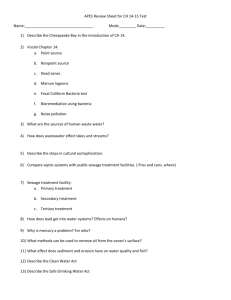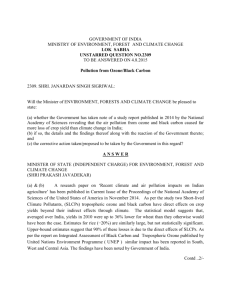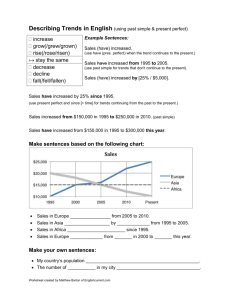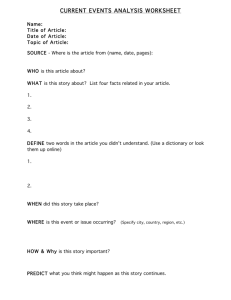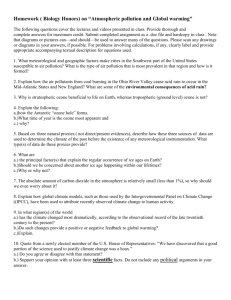AP Environmental Science Summer Assignments Environmental
advertisement
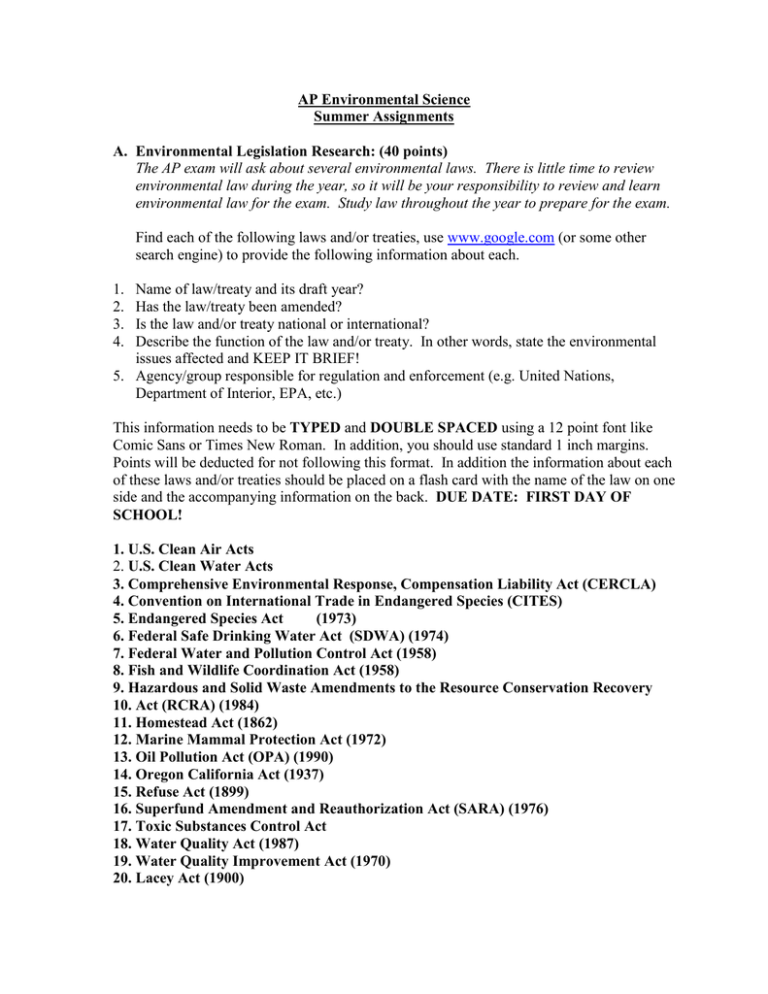
AP Environmental Science Summer Assignments A. Environmental Legislation Research: (40 points) The AP exam will ask about several environmental laws. There is little time to review environmental law during the year, so it will be your responsibility to review and learn environmental law for the exam. Study law throughout the year to prepare for the exam. Find each of the following laws and/or treaties, use www.google.com (or some other search engine) to provide the following information about each. 1. 2. 3. 4. Name of law/treaty and its draft year? Has the law/treaty been amended? Is the law and/or treaty national or international? Describe the function of the law and/or treaty. In other words, state the environmental issues affected and KEEP IT BRIEF! 5. Agency/group responsible for regulation and enforcement (e.g. United Nations, Department of Interior, EPA, etc.) This information needs to be TYPED and DOUBLE SPACED using a 12 point font like Comic Sans or Times New Roman. In addition, you should use standard 1 inch margins. Points will be deducted for not following this format. In addition the information about each of these laws and/or treaties should be placed on a flash card with the name of the law on one side and the accompanying information on the back. DUE DATE: FIRST DAY OF SCHOOL! 1. U.S. Clean Air Acts 2. U.S. Clean Water Acts 3. Comprehensive Environmental Response, Compensation Liability Act (CERCLA) 4. Convention on International Trade in Endangered Species (CITES) 5. Endangered Species Act (1973) 6. Federal Safe Drinking Water Act (SDWA) (1974) 7. Federal Water and Pollution Control Act (1958) 8. Fish and Wildlife Coordination Act (1958) 9. Hazardous and Solid Waste Amendments to the Resource Conservation Recovery 10. Act (RCRA) (1984) 11. Homestead Act (1862) 12. Marine Mammal Protection Act (1972) 13. Oil Pollution Act (OPA) (1990) 14. Oregon California Act (1937) 15. Refuse Act (1899) 16. Superfund Amendment and Reauthorization Act (SARA) (1976) 17. Toxic Substances Control Act 18. Water Quality Act (1987) 19. Water Quality Improvement Act (1970) 20. Lacey Act (1900) 21. Nuclear Waste Policy Act (NWPA) (1982) 22. Surface Mining Control and Reclamation Act (1977) 23. Emergency Planning & Community Right-to-Know Act (EPCRA) 24. Occupational Safety and Health Act (OSHA) (1970) 25. Wilderness Act (1964) 26. National Environmental Policy Act (NEPA) (1969) 27. Ocean Dumping Ban Act (1988) 30. Marine Protection, Research and Sanctuaries Act of 1972 (MPRSA) 28. Wild and Scenic Rivers Act (1968 and 1972) 29. Energy Policy Act (EPACT) (1992 and 2005) B. The Environment in the News Scrapbook: (60 points) The AP exam has extended response questions about real world problems involving the environment. Looking at real world current events improves your knowledge on what difficulties people are experiencing due to pollution issues and struggles between government and citizens. 1. Find six (5) newspaper articles related to Environmental Science (Articles do not need to be consecutive weeks but the articles need to be from six different weeks.). If you are on vacation, look in the local paper – there will be something – TRUST ME! You may use articles from newspapers and magazines on-line BUT the date of the event MUST be on the article. The date you print the article IS NOT ACCEPTABLE for a date. Failure to include the date will result in NO CREDIT for that article! 2. Summarize the relevant facts of the article in 100-200 words. 3. Additional Summary information to be answered in a separate paragraph using COMPLETE SENTENCES. a) How is the article environmentally related? b) What bias (if any) does the author have? What leads you to this conclusion? 4. The summaries must be typed in a 14 point font such as Comic Sans or Times New Roman. 5. Paste/tape the summary on the same page as your article. 6. Create a Table of Contents for the first page using the following format: Title of Article Source Date Page 7. The articles you choose MUST have some “substance” and MUST have a clear connection to environmental science. DUE DATE: THE FIRST DAY OF SCHOOL! *Topics for the course are listed below. This may help you to select a wider range of articles that interest you. Topic Outline for APES Introduction Chapter 1: Studying the State of Our Earth Chapter 2: Environmental System The Living World Chapter 3: Ecosystems Ecology Chapter 4: Global Climates and Biomes Chapter 5: Evolution Biology Biological and Human Population Chapter 6: Population and Community Ecology Chapter 7: The Human Population Earth Systems and Resources Chapter 8: Earth Systems Chapter 9: Water Resources Land Use Chapter 10: Land, Public, and Private Chapter 11: Feeding the World Energy resources and Consumption Chapter 12: Nonrenewable Resources Chapter 13: Achieving Energy Sustainability Pollution Chapter 14: Water Pollution Chapter 15: Air Pollution and Stratospheric Ozone depletion Chapter 16: Waste Generation and Waste Disposal Chapter 17: Human Health and Environmental Risks Global Change and a Sustainable Future Chapter 18: Conservation of Biodiversity Chapter 19: Global Change Chapter 20: Sustainability, Economics and Equity C. Book Assignment (50 points) Reading chapters out of the book is very important in college. This skill requires discipline and routine which several students lack. This part of the assignment trains you to read the text and answer questions to get a head start on the content. We will not have the time to cover all of the details the AP exam will require you to know. Be sure to answer all of the questions assigned or you will miss content. You will get a quiz the first week of school on this content, so you are responsible of all three chapter’s content. 1. Chapter 1: Studying the State of Our Earth Carefully Read pp 1-22 - Answer all “check points” in the chapter. All answers must be in complete sentences. - Answer all multiple choice questions on pp 23-24. You can just write the letter of your choice. - Answer all of the Free Response Questions (FRQs) on p 24. All answers are in complete sentences. - Measuring Your Impact on p 25: List your activities in each environmental indicators. 2. Chapter 2: Environmental Systems Carefully Read pp 27-48 - Answer all check points in the chapter in complete sentences. - Answer all multiple choice questions on pp 49-50. - Answer all of the FRQs on p 51. All questions must be in complete sentences and all calculations must be stepped out. 3. Science Applied: Were we successful in halting the growth of the ozone hole? Carefully Read pp 52-55 - Answer the following questions in complete sentences: 1) Why do we need an ozone layer in the upper atmosphere? 2) How do chlorofluorocarbons damage the ozone layer? 3) Write the reactions which create ozone and causes ozone depletion. 3) How did nations address the ozone crisis? 4. Chapter 3: Ecosystem Ecology Carefully Read pp 57-82 - Answer all check points in the chapter in complete sentences. - Answer all multiple choice questions on pp 82-84. - Answer all FRQs on p 84 in complete sentences.

